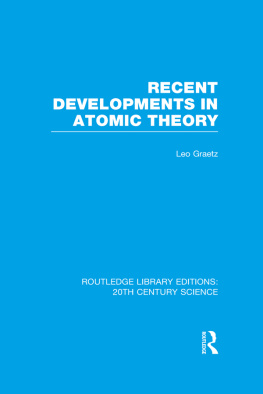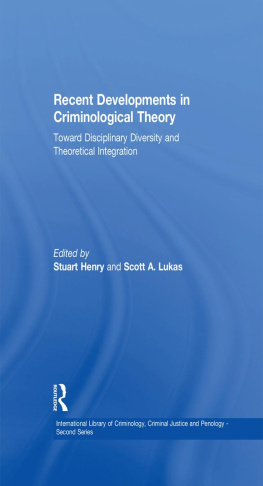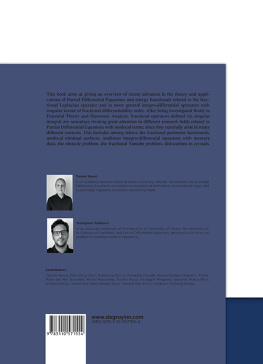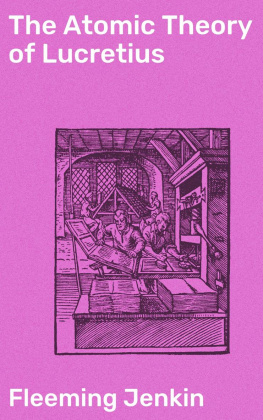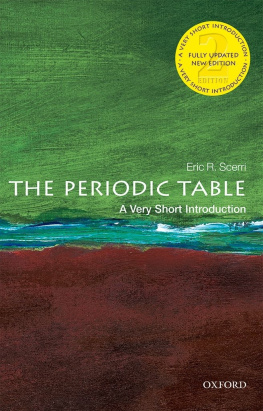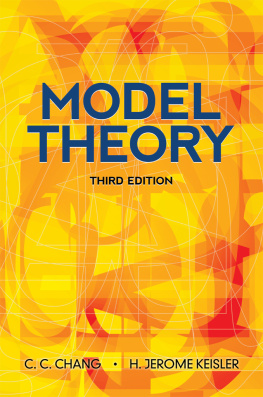ROUTLEDGE LIBRARY EDITIONS:
20TH CENTURY SCIENCE
Volume 8
RECENT DEVELOPMENTS IN ATOMIC THEORY
RECENT DEVELOPMENTS IN ATOMIC THEORY
LEO GRAETZ
Translated by
GUY BARR
First published 1923
This edition first published in 2014
by Routledge
2 Park Square, Milton Park, Abingdon, Oxon OX14 4RN
and by Routledge
711 Third Avenue, New York, NY 10017
Routledge is an imprint of the Taylor & Francis Group, an informa business
1923 Leo Graetz
All rights reserved. No part of this book may be reprinted or reproduced or utilised in any form or by any electronic, mechanical, or other means, now known or hereafter invented, including photocopying and recording, or in any information storage or retrieval system, without permission in writing from the publishers.
Trademark notice: Product or corporate names may be trademarks or registered trademarks, and are used only for identification and explanation without intent to infringe.
British Library Cataloguing in Publication Data
A catalogue record for this book is available from the British Library
ISBN: 978-0-415-73519-3 (Set)
eISBN: 978-1-315-77941-6 (Set)
ISBN: 978-1-138-01355-1 (Volume 8)
eISBN: 978-1-315-77932-4 (Volume 8)
Publishers Note
The publisher has gone to great lengths to ensure the quality of this book but points out that some imperfections from the original may be apparent.
Disclaimer
The publisher has made every effort to trace copyright holders and would welcome correspondence from those they have been unable to trace.
RECENT DEVELOPMENTS IN ATOMIC THEORY
BY
LEO GRAETZ
TRANSLATED BY
GUY BARR, B.A., D.Sc.
WITH THIRTY NINE ILLUSTRATIONS
METHUEN & CO. LTD.
36 ESSEX STREET W.C.
LONDON
First Published in 1923
PRINTED IN GREAT BRITAIN
PREFACE TO THE GERMAN EDITION
T HE subject-matter of these lectures, which were delivered in different places, some of them in the territory occupied during the war, is, as I have been able to satisfy myself, of general interest, not only to students of physics and chemistry but to the majority of people of a scientific turn of mind. It seemed therefore to be worth while to make these lectures available to a wider circle, especially as I have striven in them to make clear the steps by which the recent revolutionary views about atoms have been obtained, and to illustrate the advances which have been made by their means in the explanation of many phenomena. The fact that these new conceptions are still incomplete, and still present various difficulties and obscurities which can only gradually be removed, does not in the least affect their value, but only shows that science has here penetrated into a new and unknown but fruitful territory.
MUNICH, August, 1918.
The fourth edition has been enlarged, particularly by a discussion of the recent brilliant investigations of Aston on isotopes and of Rutherford on the structure of nuclei.
MUNICH, February, 1922.
TRANSLATORS PREFACE
V ERY few deviations have been made from the fourth German edition. I have not hesitated, however, in using nomenclature to which English readers are accustomed, in preference to a simple transliteration of the German equivalent, in cases of divergence. The list of isotopes at the end of the third chapter has been extended in accordance with the later work of Aston and Dempster. Some sections of the sixth chapter, dealing with the nuclei of range 79 cms. which Rutherford found among the products of disintegration of nitrogen and oxygen and designated provisionally as X3, have been omitted1 in view of his recent statement that these particles appear to have their origin, not in the atoms of the gas, but in the source of -raysused for bombardment.
GUY BARR
December, 1922
With the concurrence of the authorL. G.
CONTENTS
The atomic theory in chemistry and in physicsAtoms and moleculesMonatomic and polyatomic molecules of the elementsAtomic weightsProuts hypothesis The periodic system of the elementsKinetic theory of gases The absolute size and mass of molecules and atomsThe Loschmidt and Avogadro numbersVortex theory of the atomIndivisibility contradicted by the spectra of the elements.
Ions in electrolysisFaradays lawThe atomistic structure of electricityElectronsElementary chargeDischarge through gasesCathode raysFree negative electronsApparent massSize and mass of negative electronsPositive raysPositive electricityNeutral and electrically charged atoms and moleculesPositiveray analysis
Uranium, radium, thorium and actinium as radio-active substancesThe ,-- and -raysThe -particles are helium ions with a double positive chargeEmanationDisintegration of atomsThe ions of helium are constituents of the atoms of radio-active substancesWilsons photographs of -raysScattering of -particlesRutherfords theory of the atomThe positive charge of the nucleus is equal to the ordinal number of the atomMass is apparentSize of the nucleusIsotopes of radio-active elementsIsotopes of ordinary elements according to Aston
Diffraction phenomena as evidence of undulatory nature of lightDiffraction of X-rays by crystalsBraggs conception of diffraction imagesX-ray spectraThe K-, L- and M-linesMoseleys law of high-frequency spectra Order of elements and gaps in the periodic systemComposition of nuclei.
The production and appearance of line spectraNo analogy with sound-wavesBalmers lawBalmers series in hydrogenInfra-red hydrogen linesRydbergs constantSeries linesBohrs construction for the atomThe quantum of energy and the WirkungsquantumRadii of orbits and velocity of electronsWork of separationBohrs atom gives Balmers series and Rydbergs constant for hydrogenThe atom of heliumIonisation potentialMore complex atomsHigh frequency spectra and Moseleys lawAccomplishments and difficulties of Bohrs model of the atom.
Chemistry of the atom and physics of the nucleusHydrogen nucleusDecomposition of nitrogenPossibility of a hydrogen doubletClues to the investigation of structure of atoms and ionsThe first four elements, hydrogen, helium, lithium and berylliumStudies of the arrangement of the external electrons in elements of higher ordinal numberFormation of molecules by common ringsThe hydrogen moleculeA helium molecule cannot be formed.
RECENT DEVELOPMENTS IN ATOMIC THEORY
T HE early philosophers realized that, in spite of appearances, it was a fallacy to suppose that a piece of iron or glass completely fills the space which it occupies, leaving no gaps. The circumstance that all bodies contract on cooling so as to occupy a smaller space and that their volume may be reduced by pressure, shows that they could not have filled up the space before. But the gaps existing in bodies which are apparently continuous must be very small, for we have no indication of them even when we apply the most extreme magnification afforded by modern microscopes. Matter must therefore be composed of structural units, which are so small as not to be recognizable under the microscope, and these must be so assembled as to leave between them gaps of which the extent may be increased or reduced, e.g. by variations of temperature or of pressure.
This general idea has received the most complete confirmation, and has been rendered more definite by the facts accumulated by chemical research. The enormous number of chemical compounds which either occur naturally or-have been prepared in the chemists alembic, always show certain definite relationships of weight between the ingredients of which they are composed. The simple and sufficient explanation of this fact, which has been the foundation of the whole of chemistry, is that every simple


